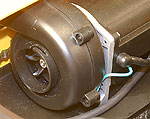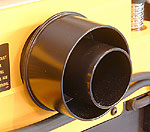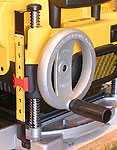This is a Veteran Owned site

 |
The DeWALT DW735 is a sweet-running machine that produces pro results at a very good price. Click image to enlarge |
DeWalt 735 13" Heavy Duty Thickness Planer
Pro shop quality and features, home shop price
Text & Photos by Tom Hintz
Posted - 9-15-2005
The DeWalt #735 thickness planer has been one of the most-requested machine reviews for months at NewWoodworker.com. As I would discover after thrashing the DeWalt #735 in my shop, my viewers were right on the money in their assessment of this machine.
Initial Impressions
The outward appearance of the DeWalt #735 suggests a well-made machine. The plastic parts are cleanly made and the metal parts precisely machined, all signs of quality manufacturing. The 90
 |
The 15-amp motor is compact but powerful. Brushes can be changed to prolong its life if needed. Click image to enlarge |
lbs + weight adds to that assumption. The controls are nicely located with large, easy to use handles.
Power
The DeWalt #735 features an 110V, 15 amp, 10,000-RPM motor that powers the cutter head through a smooth-running belt drive. The motor is protected by an external, push button circuit breaker that can be reset by the user.
To extend the life of the DeWalt #735 motor, user replaceable brushes are included. Access to the brushes is easy, requires no special tools and the procedure is explained in detail in the instruction manual.
Dust Collection
Someone on the DeWalt #735 design team deserves a big gold star for adding the blower section to the motor. While the idea is great, the execution is amazing.
Before starting the DeWalt #735, I connected my Delta #50-760 dust collector (DC) to the included 4"-diameter port adapter. During the first test cuts I could not see any dust in the clear plastic, 4"-diameter hose, making me think the DeWalt #735 was loading up inside. Then I noticed the storm of chips blowing into the DC catch bag. The dust and chips were exiting the port so fast I couldn't see them. Later, I turned the DeWalt #735 on before the DC and that small-appearing blower section fully inflated the top and bottom DC bags through 15-feet of 4" hose!
The depth lock feature is easy to use and very precise. Click image to enlarge |
The DeWalt #735 comes with the hose adapter for DC units plus another flat dispersal hood that deflects the chips downward if a DC is not available. Both adapters lock onto the port with a twist-lock mechanism that insures they do not blow off during operation. Considering the power of the blower section, this is a good idea.
Depth Lock
In addition to the 0 to 6" vertical scale, the DeWalt #735 has a dial-operated depth lock with internal detents that limit minimum thickness between 1/8" and 1 ¼", all in ¼" steps above the 1/8" setting. The detents contact a threaded rod on the base that makes calibrating this feature simple, if needed at all. Our DeWalt #735 came out of the box with this setting properly calibrated.
 |
The cut depth indicator, next to the speed-change switch makes those first cuts less exciting. Click image to enlarge |
Depth of Cut Indicator
Setting a planer for the first cut has been a hit and miss proposition but the DeWalt #735 has a nifty solution. As the cutter head is lowered onto the stock to be cut, an internal bar contacts the wood and moves an indicator on the front of the machine that shows how much wood will be removed at that setting. The indicator points to a chart with suggested maximum cut depths for common stock widths.
Thickness Setting & Snipe Reduction
The large hand wheel makes even tiny height adjustments easy. The internal snipe reduction device engages automatically and is very effective. Click image to enlarge |
An oversized 7"-diameter hand wheel raises and lowers the cutting head 1/16" per full revolution making ultra fine adjustments easy and very accurate. The vertical 6" scale has an adjustable indicator that can be fine-tuned to correct for parallax errors caused by varying operator heights.
Another important feature of the DeWalt #735 is the very effective and automatic snipe-reducing device that engages after each height change. This device engages the four heavily threaded, 1"-diameter corner posts to virtually eliminate snipe.
It is important to remember that poor operator technique such as tilting the board as it enters the cutters will force any planer to produce snipe. The DeWalt #735 makes it easier to keep the wood straight with the standard 13"-wide by 19 ¾"-long table. Extension tables are available that substantially increase this support.
Dual Feed Rates
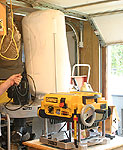 |
Notice me holding the unplugged power cord for the dust collector that is being inflated by that little blower section on the DW735 motor! Click image to enlarge |
The DeWalt #735 has two CPI (Cuts Per Inch) rates that make effective use of the three-knife cutter head. For dimensioning or cutting soft wood, the faster 96 CPI rate (speed #2 – 26 feet-per-minute) is used. When making finish cuts or when cutting hard woods the #1 speed slows the feed rate to produce 179 cpi (14 feet-per-minute) which also reduces stress on the knives.
It is important to change feed rates only when the DeWalt #735 is running. Shifting speeds "on the fly" may seem like a good way to damage the mechanism but is actually how it is protected. It also eliminates having to shut the machine down to reset it for a final, finishing pass.
Blade Changing
 |
Changing the two-sided blades is easy using the included wrench that also has magnets in the handle for picking up the blades. Click image to enlarge |
The DeWalt #735 uses 3, two-sided blades that effectively doubles their life. Changing them is made easy by an automatic cutter head lock that engages when the top cover is removed. The same Allen wrench (included) used to remove the cover also fits the blade retaining bolts. After the bolts are removed, flip the wrench over and use the imbedded magnets in the handle to remove the retainer and blade.
The blades fit over alignment pins that eliminate the headaches older machines induced when trying to align them properly. Turn the old blade around to use the fresh edge or install a new one using the magnets in the handle. Reinstall the bolts and move on to the next blade.
The instructions describing the blade changing procedure are very good and should be kept handy.
In the Shop
 |
Reducing a glued-up oak panel to 1/8" produced a smooth surface and no chipping, splitting or cracks. Click image to enlarge |
The DeWalt #735 arrived in the NewWoodworker.com shop at an opportune time as several planning tasks in various thicknesses and wood species were on the bench. After unpacking and checking the accuracy of the height scale and stops, (only the vertical scale indicator needed a tiny adjustment) a few pieces of scrap pine were run through to confirm those settings and insure the DeWalt #735 was operating normally.
Throughout testing, the DeWalt #735 produced very smooth surfaces on oak, pine, hard maple, bass and spalted maple. While it handled material ½" and thicker with ease, (with no snipe) I was most interested in the performance at the thinnest end of 6" to 1/8" range.
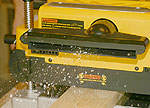 |
This flat, dust deflector is included but if you have a dust collector, use it! The internal blower shoots the chips farther than you might suspect. Click image to enlarge |
A ¼"-thick by 12"-wide piece of oak (2 piece glue up) was reduced in 1/16" passes to 1/8" using the dimensioning speed. The piece emerged from the final cut perfectly flat, very smooth and showing no snipe, chipping, cracks or splits.
A 6-foot-long (8"-wide) piece of ambrosia maple was next. The first cut was made feeding the stock onto the table by hand. While the surface was very smooth, a small amount of snipe was visible on the leading end, caused by me not holding it flat to the table as it entered the rollers.
Prior to the next cuts I set up roller stands to the front and rear, making sure they were level with the DeWalt #735 table. Using the stands to keep the board flat with the table eliminated all snipe. All subsequent boards planed using the stands also showed no snipe, further confirming me as the culprit on the first cut.
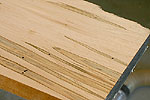 |
With a work stand to support long boards, no snipe was found Click image to enlarge |
The surface finish produced by the dimensioning and finishing speeds was often hard to distinguish in softer woods. Both were exceptionally smooth and would require only the finest of sanding to ready for finish. Red oak was slightly smoother when cut at the finish setting but still would require little sanding.
The chip ejection worked perfectly with my Delta 50-760 dust collector attached. During most cuts, there were no chips left on the wood or table.
I did try one pass using the included deflector rather than the dust collector. Again, the DeWalt #735 remained virtually chip free, something I could not say for my shop floor. The deflector does confine the mess to a relatively small area but I chose to use the dust collector for all other tests.
Conclusions
 |
A pair of sliding rails on top make getting the board back for another cut easy for one person in a small shop. Click image to enlarge |
The DeWalt #735 refused to do anything but perform perfectly with the exception of the one small instance of snipe I caused by feeding the board in at an angle. It has plenty of power driving the cutter head, the enhanced chip ejection is the best I have seen on a planer and the finish produced in both cutting speeds is first rate.
The cut depth indicator is both handy and accurate, making first cuts less of an adventure. The large depth crank is smooth and makes sneaking up on a precise final dimension very easy. The depth stop system is easy to use, dead-on accurate and will make many production-type tasks fast.
Even changing or reversing the two-sided blades is quick, accurate and simple, something many other planers cannot match. This is an important point as some planers never seem to work as well after the first blade change. The DeWalt #735 performance does not suffer from those problems.
With a street price of $499.99, (9-14-2005) the DeWalt #735 is as cost effective as it is efficient. If it is time to add a planer to your shop, or upgrade from an older model, the DeWalt #735 is a must see.
Have a comment about this review? - Email Me!
All written, photographic and drawn materials are property of and copyright by NewWoodworker.com LLC 2000-2019. Materials may not be used in any way without the written permission of the owner.

